Olam International is calling for retailers and food brands to back the new “Sustainable Rice Platform-Verified” Assurance Scheme and consumer pack label, which will allow consumers to choose products that directly support efforts to increase farmer incomes and reduce the environmental impact of rice production.
Speaking ahead of UN Climate Week, Paul Nicholson, Head of Rice Research and Sustainability for Olam’s global rice business said, “Unlike crops such as coffee and cocoa, consumers have no awareness of the sustainability issues associated with rice, and therefore, no impetus to change them. This label can help galvanise consumer action behind rice – an affordable food that’s unique in its international appeal and the largest food source on earth.
“I know that a label cannot transform a sector overnight, but it can give consumers a chance to catalyse real change. It can give brands a purpose-driven marketing campaign and allow brands and retailers to lead from the front.
As Olam has experienced through our own farmer engagement programmes, the SRP Standard works: farmer incomes are increasing by 10-20 per cent while methane emissions are reduced by up to 50 per cent. Now with the Assurance Scheme it will catalyse both ends of the value chain for greater scale.”
The ‘SRP-Verified’ Label has been developed by the Sustainable Rice Platform – a grouping of over 100 public, private, research, financial institutions and civil society organisations led by the development agency Deutsche Gesellschaft für Internationale Zusammenarbeit GmbH (GIZ), UN Environment Programme (UNEP) and the International Rice Research Institute (IRRI).
The majority of the world’s rice farmers earn just US$2-7 a day and paddy fields emit up to 20 per cent of global manmade methane emissions – a gas more potent than carbon dioxide.
Paul Nicholson continues, “In 2016 and in partnership with GIZ, Olam was the first private company to trial the SRP indicators with farmers in Thailand. I have seen first-hand what a difference it is making. At Olam we are intent on supporting this initiative to supply SRP-verified rice to allow our customers and partners to re-imagine this sector by improving the livelihoods of farmers and their families, and protecting the environment.
Rice is integral to the global food security system. 144 million households are growing the world’s rice, yet 90 per cent are living at or near the poverty line.
Through SRP, women – often the main labourers – are able to gain their own land tenure certificates. It is also enabling freshwater to be preserved as farmers are learning to keep records, to reduce water, to reduce pesticides. Migratory birds can feed in the vital wetlands without risk of contamination or culling, eating pests naturally.
Paul Nicholson continues, “Our team in India is working with a community who had drawn so much groundwater for irrigation that their community water-source has turned saline. Through the SRP Standard we are helping them to reduce water use and recharge the local aquifer to address the balance between agriculture and local water use.
“Thanks to partnerships with GIZ, as well as the International Fund for Agricultural Development (IFAD), International Finance Corporation (IFC) and respective governments, we are currently providing SRP Standard training to about 35,000 farmers in Nigeria, 750 in India, 10,000 in Thailand and 4,000 in Vietnam. But our vision is to see the SRP Standard scaled by the sector so that the label is just as accessible on consumer packs in those domestic nations as it is in international markets.
Other actions being taken by Olam’s rice team and our partners include:
- Putting data into the hands of customers through Olam’s revolutionary supply chain sustainability insights platform AtSource, which tracks 150 data points across 9 core sustainability topics, connected to 12 Sustainable Development Goals. In addition to monitoring the farm-level indicators under SRP and any additional requirements from customers, AtSource provides social and environmental footprints for the full journey of the product – through processing and logistics to the manufacturer’s door. Tools include country risk assessments and an eco-calculator that can give carbon, water and land use change footprints per tonne of product, essential when reporting impacts for third party supply chains.
- Participating in sector-wide initiatives including the Sustainable Rice Landscapes Initiative (SRLI).
- Through Olam’s Re-Imagineers programme, we are actively exploring opportunities to commercialise rice biomass straw to unlock value for farmers and Olam into packaging and other uses.
Five facts about global rice production
1. Worldwide, 3.5 billion people consume rice and 144 million family farmers produce rice, tragically some 90 per cent of them live at or near the poverty line – many of them are women
2. 1 out of 4 farmers in the world are rice smallholders, who earn on average US$2 to US$7 per day from rice
3. Irrigated rice cultivation uses 30-40 per cent of the world’s freshwater and is responsible for 10 per cent of global man-made methane emissions
4. Rice production is a leading cause of habitat loss, both in wetlands and forests
5. Global rice consumption is projected to grow 13 per cent from 2018 to 2027, requiring 500 million tonnes of milled rice annually
Publish your content with EB Publishing
It's about who you reach. Get your news, events, jobs and thought leadership seen by those who matter to you.











